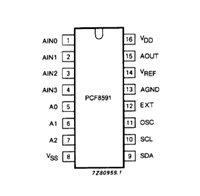NTC Thermistors
General Characteristics
2.2.5. Voltage – Current curves V (l)
These curves describe the behavior of the voltage drop V
measured across the NTC as the current l through the NTC
is increased.
2.2.7. Thermal time constant
When a thermistor is self-heated to a temperature T above
ambient temperature Tamb, and allowed to cool under zero
power resistance, this will show a transient situation.
They describe the state of equilibrium between power
resulting from Joule effect and dissipated power in the
surroundings. (Figure 4)
At any time interval dt, dissipation of the thermistor
(␦(T – T
)dt) generates a temperature decrease –HdT,
amb
resulting in the equation:
1
␦
H
dT = -
dt
(T - T
)
amb
The solution to this equation for any value of t, measured
from t = 0, is:
V
Vmax
(T - T
(To - T
)
␦
H
amb
ᐍn
= -
t
)
amb
We can define a thermal time constant as:
= H/␦ expressed in seconds.
Where the time t = :
(T - T ) / (To - T
I
o
I
) = exp - 1 = 0.368
amb amb
Figure 4 – Voltage – current curve V (l)
expressing that for t = , the thermistor cools to 63.2% of the
temperature difference between the initial To and Tamb (see
Figure 5).
Several zones can be identified:
– low current zone
According to IEC 539 our technical data indicates mea-
dissipated energy only produces negligible heating and
the curve V (l) is almost linear.
sured with To = 85°C, T
T = 47.1°C.
= 25°C and consequently
amb
– non-linear zone
the curve V (l) displays a maximum voltage Vmax for a
current lo.This maximum voltage Vmax and the temper-
ature Tmax reached by the NTC under these conditions
can be determined by using the equations:
2
T (°C)
85
P = V /R = ␦ (T - T
amb
)
and
R = Ramb • exp B (1/T - 1/T
)
amb
therefore:
+
1 T
47.1
25
amb
ͱ
2
(
)
~
Tmax = B/2 - B /4 - BT
T
B
amb
amb
1 - 1
max amb
ͱ
t
-
Vmax = ␦ (T
T
) • R
amb
exp B
(
T
)
t (s)
max
amb
[
T
]
Figure 5 – Temperature – time curve T(t)
where ␦ is the dissipation factor and T
ent temperature.
is the ambi-
amb
2.2.8. Response time
More generally, it is possible to define a response time as the
time the thermistor needs to reach 63.2% of the total
temperature difference when submitted to a change in the
thermal equilibrium (for example from 60°C to 25°C in
silicone oil 47V20 Rhodorsil).
– high current zone
for higher currents, an increase in temperature of the
NTC decreases the resistance and the voltage more
rapidly than the increase of the current. Above a certain
dissipated power, the temperature of the NTC exceeds
the permissible value.
2.2.6. Current – Time curves l(t)
When voltage is applied to a thermistor, a certain amount of
time is necessary to reach the state of equilibrium described
by the V(l) curves.
This is the heating up time of the thermistor which depends
on the voltage and the resistance on one side and the heat
capacity and dissipation on the other.
The curves l(t) are of particular interest in timing applications.
5







 STM32F030C6芯片介绍:主要参数分析、引脚配置说明、功耗及封装
STM32F030C6芯片介绍:主要参数分析、引脚配置说明、功耗及封装

 PCF8591数据手册解读:参数、引脚说明
PCF8591数据手册解读:参数、引脚说明

 一文带你了解ss8050参数、引脚配置、应用指南
一文带你了解ss8050参数、引脚配置、应用指南

 深入解析AD7606高性能多通道模数转换器:资料手册参数分析
深入解析AD7606高性能多通道模数转换器:资料手册参数分析
